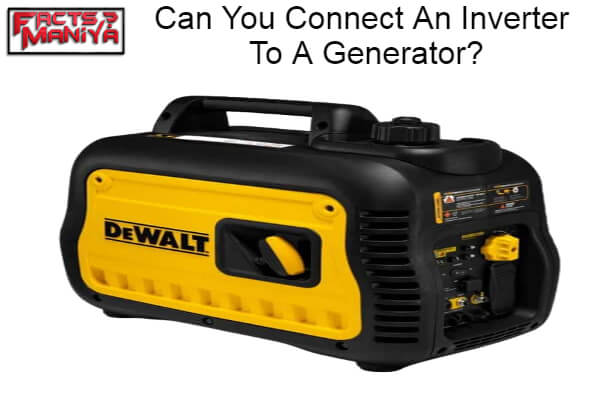Let’s begin Can You Connect An Inverter To A Generator? Inverter systems can be integrated with generator systems to achieve extended run-time during a mains power outage.

Can You Connect An Inverter To A Generator?
If you connect a grid tie solar inverter to your generator, you may damage it, and it’s unlikely that it will function. This is why the grid-tied inverters push the grid. That implies that they start injecting extra power into the grid as soon as they produce it.
Several things must occur before they begin to do this: They check the voltage on the grid first to see if it is within acceptable limits. Additionally, they scan the grid frequency, and if it isn’t stable enough, they won’t begin pushing into it.
At least in the USA, the grid generates rock-solid sine waves at 240 volts, typically 60 Hz. Unless it is a little Chinese knockoff, your grid-tie inverter likewise sources 240v. However, I’ll assume that you have a matching inverter and generator even though your generator is probably 120v.
However, internal combustion engines, typically used to power generators, struggle to operate at precisely the appropriate speed. As a result, the generator probably oscillates between 58 and 62 Hz and averages 60 Hz but isn’t exactly at that frequency.
Most solar inverters change the output’s phase angle to power the grid, which is a concern. Your inverter will begin pushing the grid once it has finished sniffing the generator and determining that it is stable enough, which can take a while (a few minutes on a SunnyBoy, for example).
By sending out a higher voltage than the grid is at, it accomplishes this in one of two ways. Your generator can become quite dissatisfied as a result. On the grid, the voltage may drop by less than a tenth if you abruptly turn on your water heater, which consumes about 12,000 watts.
If you are using a 20,000-watt generator to run your water heater, the engine will sputter as the throttle is increased to accommodate the demand, and the voltage may drop by 30 volts or more for a brief period. Your inverter will notice the “grid” fade out, disconnect, and resume waiting for grid stability if it actively tries to push on it.
Controlling the AC frequency is another way inverters manage how much energy they feed into the grid (phase angle.) So it’s clear that the inverter won’t function if your generator’s frequency is all over the place.
How Can I Connect A Solar Inverter To My Generator For The Power System?
NOT YOU. You can get anything you want. However, only qualified experts who work with this equipment can safely accomplish it. Although there are specialized converters that can adapt and combine the various power sources you indicate, as an electrical engineer who has worked for almost 50 years, I would never even consider trying to do this on my own.
Why Does My Solar Inverter Give Less Input?
The specifications for your Apollo AW3000VA inverter/charger were nowhere to be found. However, I assume it only has one channel. This implies that the voltage must be the same for each string you join in parallel.
You have ten panels, each producing its maximum output power at roughly 30.5V. Under lower light levels, they’ll probably produce a little less energy, but you still want your inverter/charger to function effectively even when solar illumination isn’t optimum.
As you stated, your inverter/charger requires a DC input between 30V and 66V. In other words, you can connect two panels in series across the input and a single panel across the input, but not three or more panels in series.
It is possible to connect all ten panels in parallel. The alternative option is to divide them into sets of two connected series, then pair them off and join them in parallel. This is the choice I would favor.
Your system will work inefficiently if the parallel connected modules aren’t adequately matched because your inverter only has one channel. Any flaws in one panel’s output (such as being in the dark, becoming dirty, cracking, or the like) will be amplified up to ten times.
When there are eight or more panels, I typically prefer to use a multi-channel inverter/charger. However, the way you have it saves money. Just remember to maintain the panels tidy and, if necessary, trim any trees or other objects that might cast shadows on them.
Be aware that if there is any fundamental imbalance in the panels, your design will function extremely poorly. This requires that all of your panels face the same direction and that none of them be cast in shadow by antennas, roof elements, or the like. Using ten panels in this layout would be a bad idea if you have this problem. Several channel inverter/chargers or multiple units must be utilized instead.
To Conclude
Hopefully, you understand Can You Connect An Inverter To A Generator? All inverters convert a DC input voltage to an AC output. Solar inverters change the input voltage from high voltage DC to mains voltage AC.
Generators create an AC voltage and, sometimes, a weak DC voltage for charging batteries. You cannot create more power unless something adds power, even if they are compatible. You constantly lose power while converting power from one form to another, owing to efficiency losses.

